
Their mouths form an upward indent, giving them the appearance of smiling.
©Andrew Sutton/Shutterstock.com
Pilot whales are an interesting species that live throughout the Atlantic and Pacific Oceans. They are a common sight for patrons going on whale watching tours as they for large pods and a select species live in warmer waters where whale tours take place. They are wonderful creatures that are still being studied because their marine life is difficult to study.
That is why this article will provide any reader with a good place to start understanding these peaceful and majestic creatures regarding their habits, diet, and threats they face.
What Are Pilot Whales
Globicephala, or pilot whales, are a species of marine mammal more closely related to dolphins than actual whales. They are one of the largest members of the dolphin family right after the orca.
There are two types of pilot whales swimming across the Atlantic and Pacific Oceans.
- Short-finned
- Long-finned
Short-Finned Pilot Whales
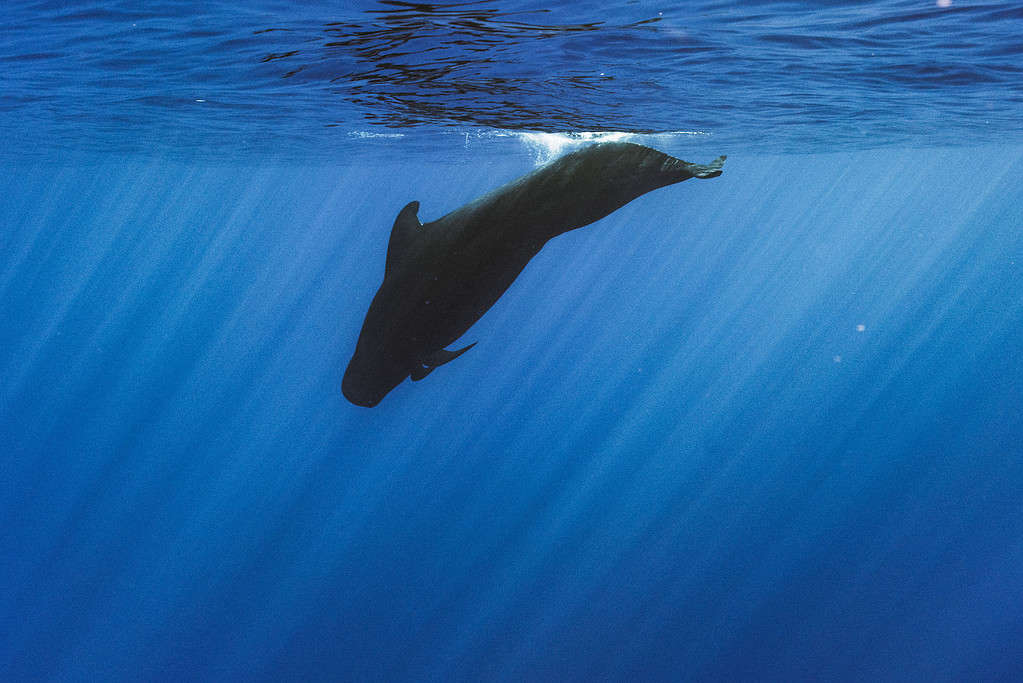
Short-finned varieties have smaller pectoral fins and are generally smaller than long-finned varieties.
©Wirestock/iStock via Getty Images
Known as G. macrorhynchus, the short-finned variety was first discovered in 1846 by John Edward Gray. Gray found bones on shore and mistook it for a whale.
Short-finned types prefer to live in tropical and subtropical waters. They swim in the warm waters across the Caribbean Islands, Australia, off the coasts of North and South America, and Europe. Whale tours will frequently spot these whales traveling up and down the coastline for food.
Typically, males have a lifespan of 45 years while females can reach 60 years old. Recent marine life studies show nearly 200,000 short-finned whales are living in the wild, with several thousand comfortably living in aquariums.
Long-Finned Pilot Whales
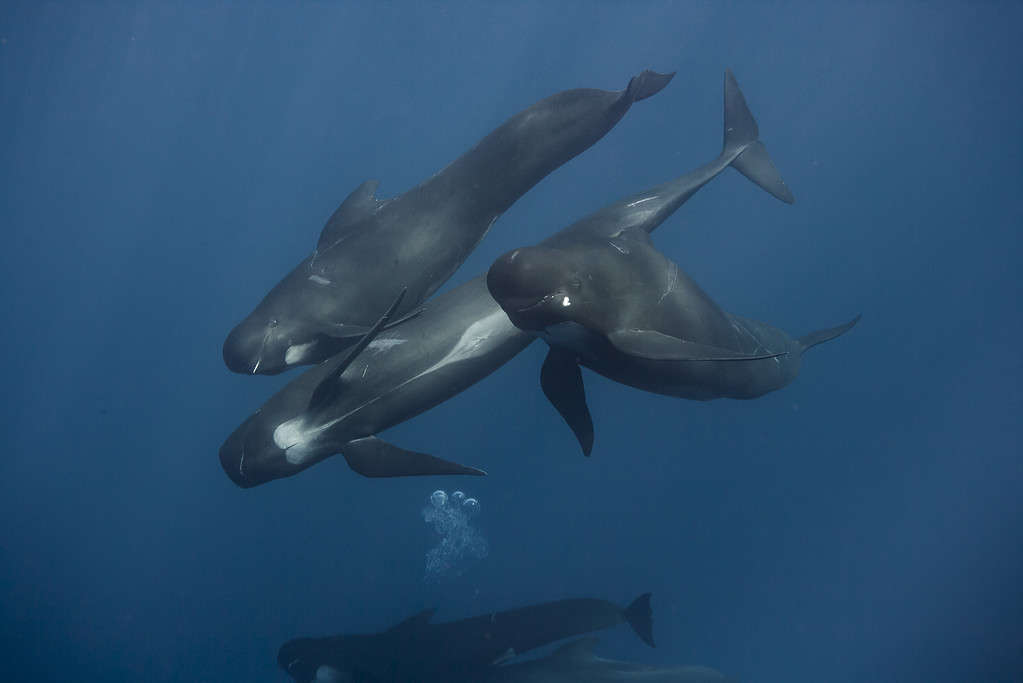
The long-finned variety has noticeably longer pectoral fins. Both whales have some white coloring.
©eco2drew/iStock via Getty Images
G. melas, or the long-finned type, prefers to live in colder waters, remaining in the open ocean for their entire life. They enjoy colder temperatures in the North and South regions of the Atlantic Ocean and the North Pacific Ocean. Unfortunately, sightings of the long-finned pilot whales in the North Pacific Ocean are so infrequent that they are absent or extinct in the area.
Long-finned types have a similar lifespan to their short-finned variants, with males living 35-45 years and females living 60 years. Approximately one million long-finned pilot whales are living in the wild, and thousands more reside in wildlife conservation locations like aquariums.
What is the Difference Between Long and Short-Finned Whales
The main difference between these whales is their pectoral fins, (the fins on the sides of their body stemming from the chest.)
As the names simply explain, long-finned varieties have long and slender pectoral fins while the short-finned variants are smaller.
Additionally, short-finned varieties are slightly smaller than the long-finned versions. Short-finned versions also have fewer teeth. Pilot whales have around 40-48 teeth, evenly spaced between their upper and lower jaws.
Are They Whales or Dolphins
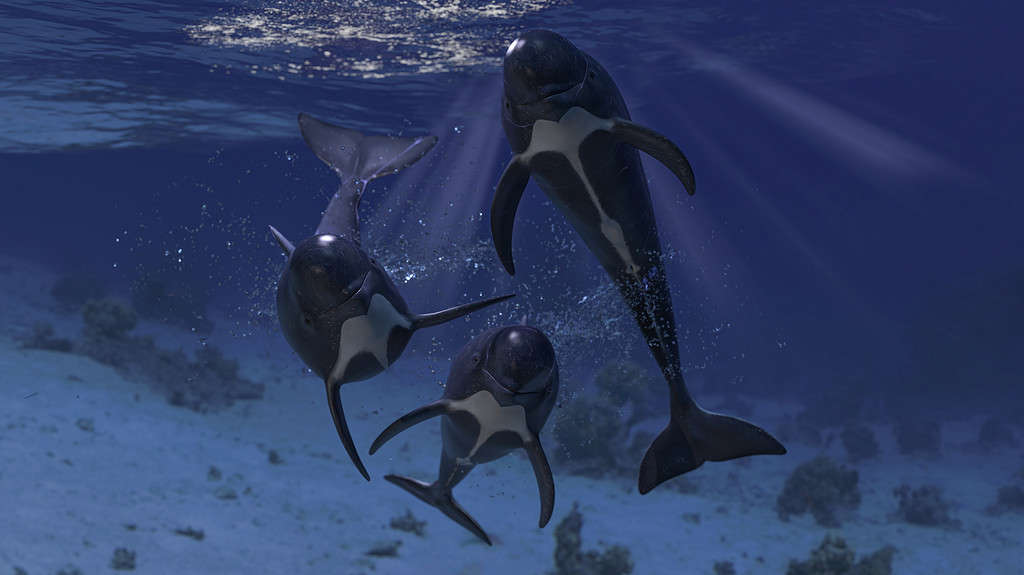
Pilot whales and orcas are the largest dolphin species.
©bbevren/iStock via Getty Images
Technically, pilot whales are very large dolphins. Dolphins are leaner and more “torpedo-like” to move through the water at faster speeds than whales.
Pilot whales communicate more closely with dolphins using a series of sounds that are audible to human ears. Whales communicate in both audible ranges and at frequencies that require machines to interpret.
A clear division between whales and dolphins is the appearance of a dorsal fin higher up on the body. Whale dorsal fins are lower toward the midsection or tail while dolphin dorsal fins are higher on their body.
Where Do Pilot Whales Live
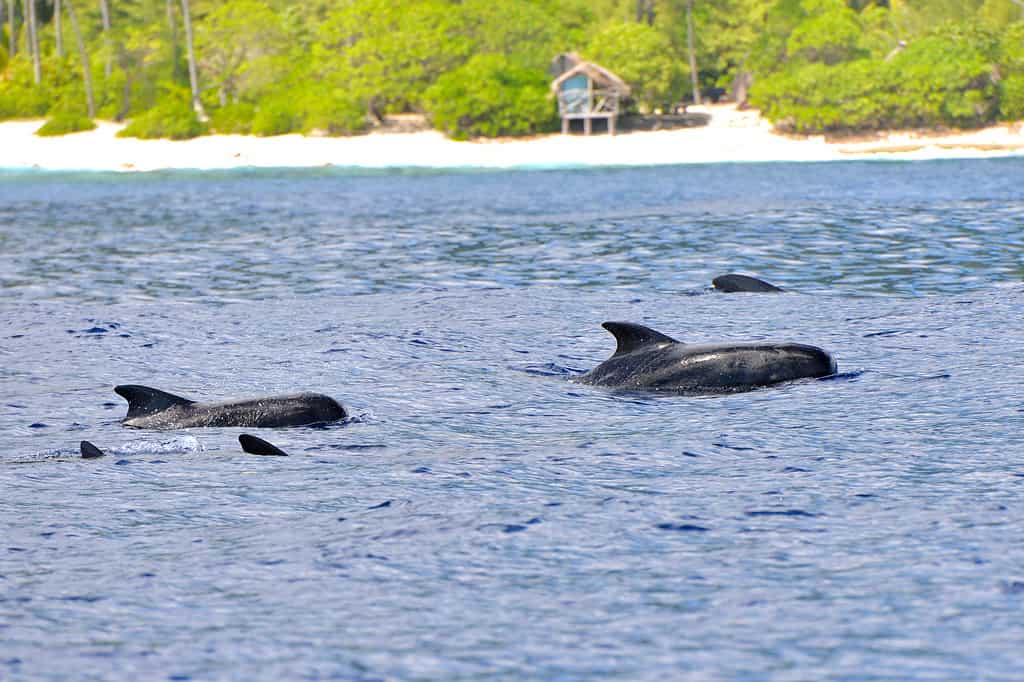
Long-finned whales primarily stay in the cold and open ocean but have been seen coming close to shore.
©Pascale Gueret/iStock via Getty Images
Pilot whale habitats range across the oceans. The exact location will depend on the type of pilot whale.
Short-finned pilot whales can live along coastal regions of tropical and subtropical areas. Common short-finned pilot whale sightings are:
- Atlantic Ocean: North and South America, Africa, Australia, Asia, India
- Pacific Ocean: North and South America, Asia, Australia
- Southern Hemisphere
Long-finned pilot whales enjoy living in colder climates near the deep ocean. Common long-finned pilot whale sights are:
- Atlantic Ocean: North American Upper East Coast, South America, Iceland, Europe, Africa, Australia
- Pacific Ocean: South America
- Southern Hemisphere
What Do Pilot Whales Look Like
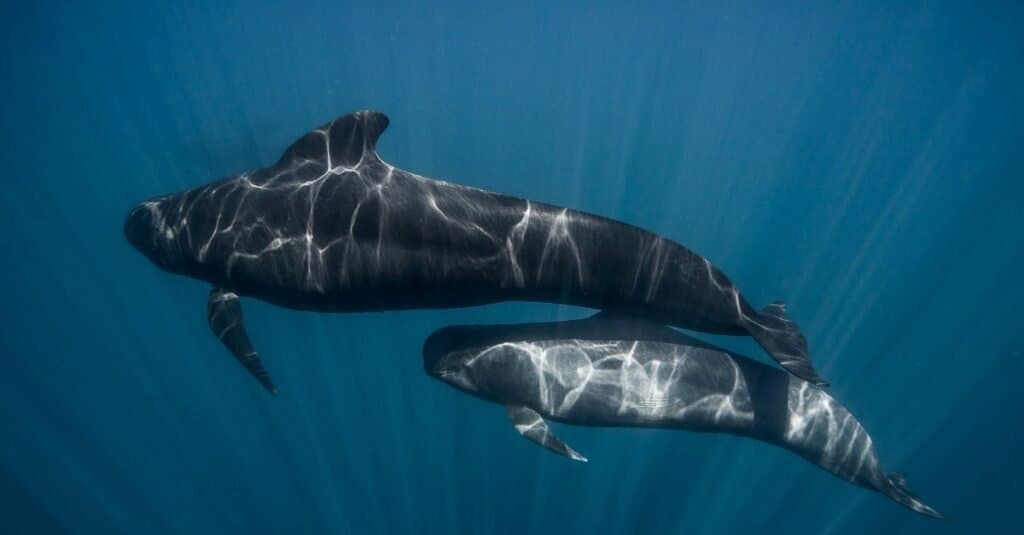
They are called
Globicephalabecause “globus” translates to globe, which describes their rounded heads.
©iStock.com/eco2drew
Generally, long and short-finned varieties look the same, despite a few small differences in their pectoral fins and body size.
Adult males can reach 7 meters or 22 feet long and weigh 3600 kilograms or nearly 8000 pounds. Females are slightly shorter than the males, reaching 4.9 meters or 16 feet long, and weigh 1361 kilograms or 3000 pounds.
Their prominent features include their bulbous head, slender dorsal spine with a small hook on the edge, and pointed tips on the edges of their flukes (ends of the tail.) Like many marine animals, they have a grey-white underside to camouflage them from predators below, with overall dark or black skin making them hard to spot when they dive.
Pilot whales have a cute trait where they have a small white pattern-like strip that extends from their face to their dorsal fin, and a mouth that curves upward, giving the whale the impression of smiling.
Pilot whales have about 40 to 48 teeth, which is fewer than the typical 70-120 teeth most dolphins possess. Scientists believe pilot whales evolved to have fewer teeth to help them catch specific prey.
Pilot Whale Social Groups
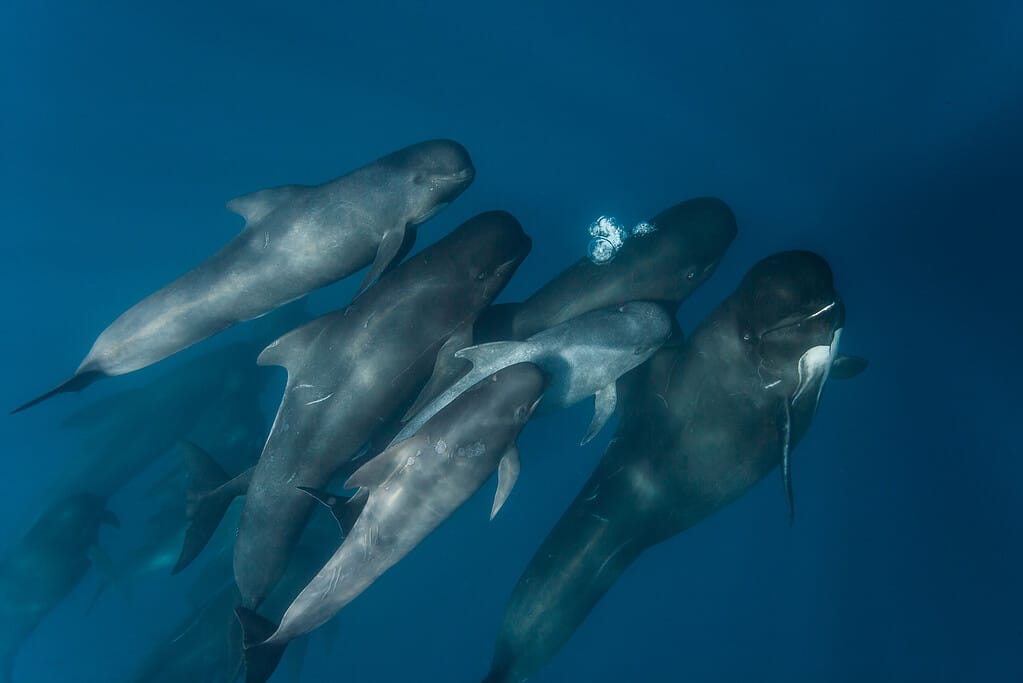
These large mammals live in pods as a way to protect their calves and to hunt prey more easily.
©eco2drew/iStock via Getty Images
Like other marine animals, pilot whales are very social. Pods have up to 20 or 30 members, with some records indicating pods of over 100 members swimming together.
They operate with matrilineal lines, meaning the calves stay with the mother for their entire life. Curiously enough, there is little inbreeding found in populations. Males stay with their pods, but pods will meet during mating seasons to reproduce.
Females reach sexual maturity at eight or nine years old, while males reach maturity around 12 to 17 years of age. Calves nurse with the mother for nearly three years before moving on to solid foods like squid and fish.
On average, pilot whales descend and travel down to depths of 30-60 meters, although they are capable of going farther down to 600 meters.
Why Are They Called Pilot Whales?
These animals are called whales because of their larger size. The species was bigger than traditional dolphins, and their bone structure looked like a whale.
The “pilot” portion of their name comes from scientists theorizing that these marine creatures follow a leader who pilots the pod around the ocean.
They are also known as “blackfish” because of their dark-skinned complexion. However, this does not relate to the documentary “Blackfish” which focuses on orcas in captivity.
What Do They Eat?

Orcas and dolphins have teeth to grab squid and fish, preventing them from escaping.
©slowmotiongli/iStock via Getty Images
Typically, these whales eat a diet of squid and a variety of fish. Squid and octopus are their primary sources of food, but they are very open to eating fish like:
- Atlantic cod
- Turbot
- Mackerel
- Herring
- Dogfish
- Hake
- Blue Whiting
Pilot whales will eat 14 kilograms or 30 pounds of food per day to sustain themselves. They hunt in large packs to target prey, using vocal commands to communicate with other members of the pod to surround the prey for easy capture.
Large marine mammals may compete with each other for food because they inhabit similar regions.
What Are Threats to Pilot Whales
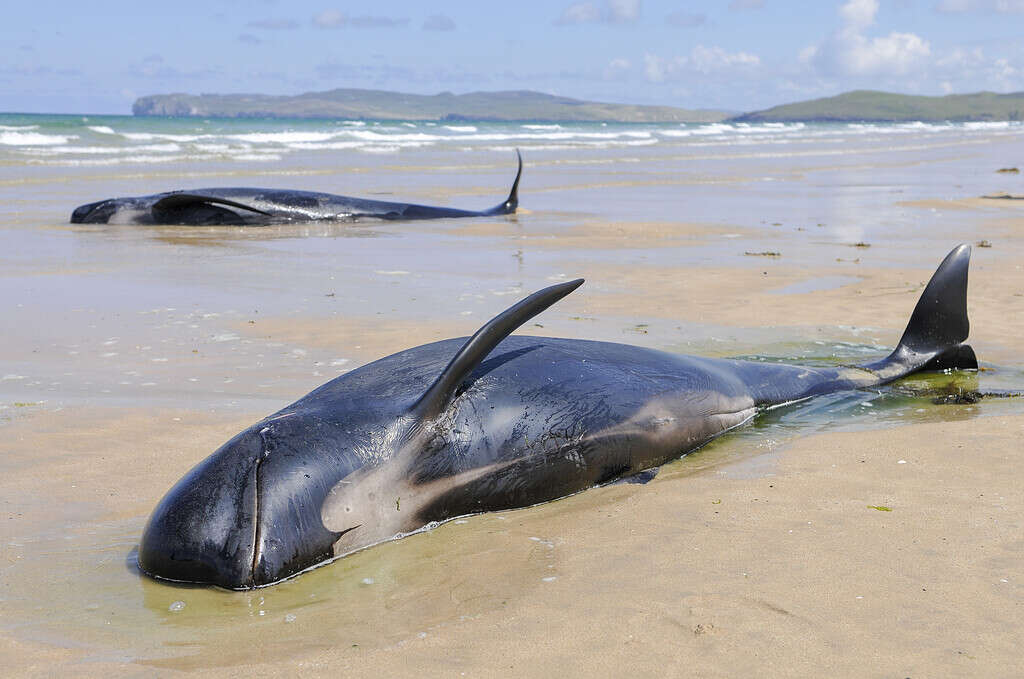
Mass strandings happen when marine life accidentally beach themselves.
©Stephen Barnes/iStock via Getty Images
Pilot whales do not have any natural predators actively hunting. Their large size and population keep the pod and calves safe from predators like sharks or killer whales. However, orca attacks have been recorded, but such incidents are rare. Additionally, sharks have been seen feeding on the carcass of a dead pilot whale, but it is very unlikely they were the cause of its death.
Primary threats consist of:
- Fishing Entanglements: Fishing vessels using long lines or trawls can accidentally catch a pilot whale, causing the animal to panic. This can cause injury or exhaustion so that the large mammal becomes susceptible to prey like a large shark.
- Whalers: Whalers are people who actively hunt whales for their meat, bones, and oil. Conservation efforts are placed across several countries to protect pilot whales from overhunting, but certain countries that do not pass the law continue hunting for income and cultural heritage.
- Vessel Strikes: Vessel strikes are the accidental collision of whales and other marine life with the rudders or propellers of the boat. These accidents are frequent when whales come too close to fishing vessels to inspect the object and are wounded when they get too close.
- Mass Strandings: Mass strandings happen when marine life accidentally beach themselves. Pilot whales are the most common marine mammal to perform mass strandings, puzzling marine biologists as to why. Several theories range from getting lost, solar storms impairing their sense of navigation, pollution, or accidentally swimming into the shallows without realizing it.
As of 2023, pilot whales have a conservation status of least concern, indicating a stable population across the oceans. While they technically are not true whales, they are a delightful species that deserves protection and care as they swim beneath the waves.
The photo featured at the top of this post is © wildestanimal/Shutterstock.com
Thank you for reading! Have some feedback for us? Contact the AZ Animals editorial team.







